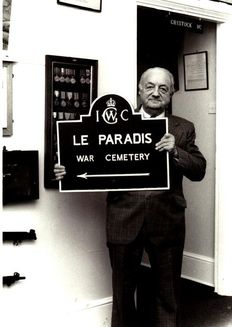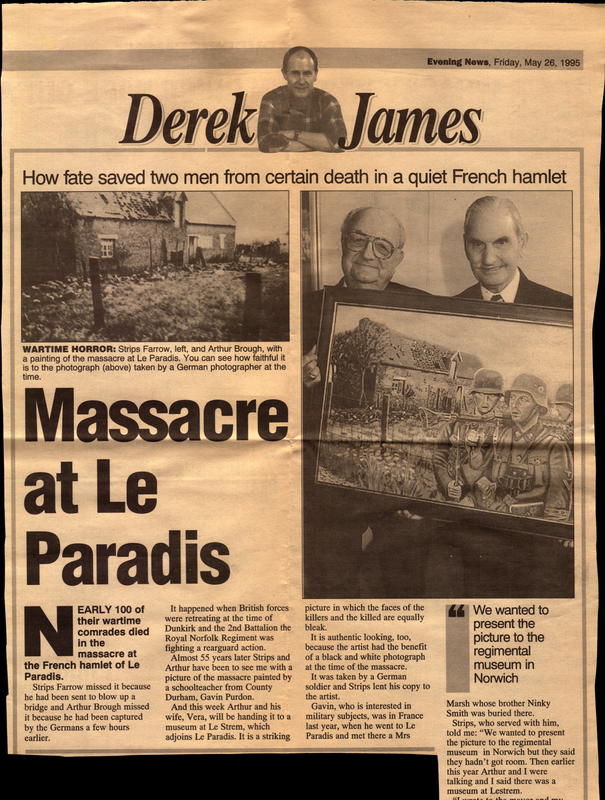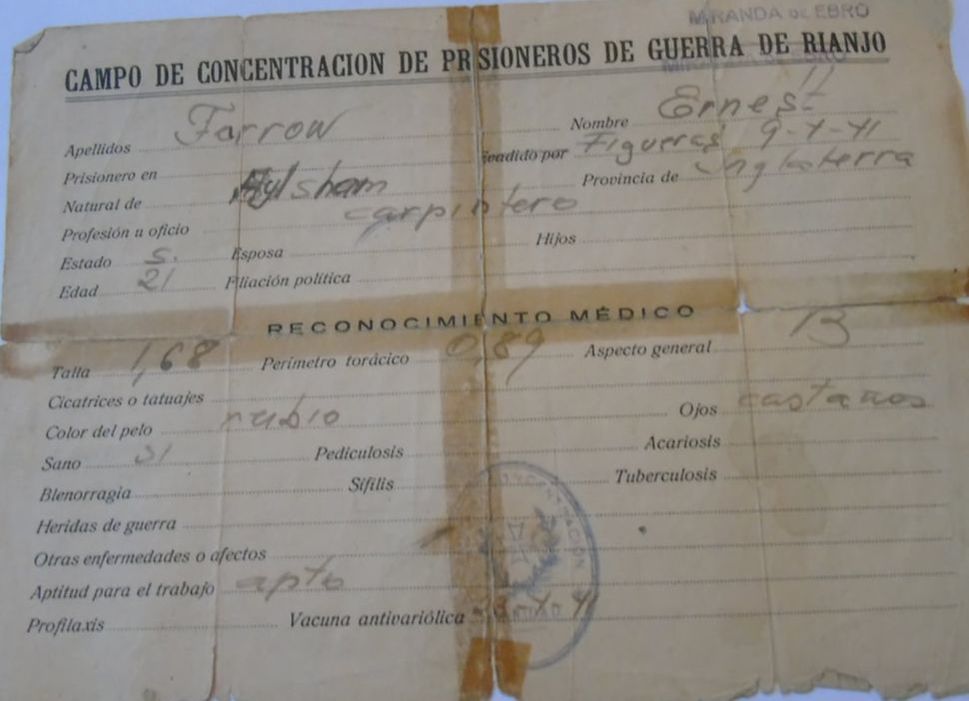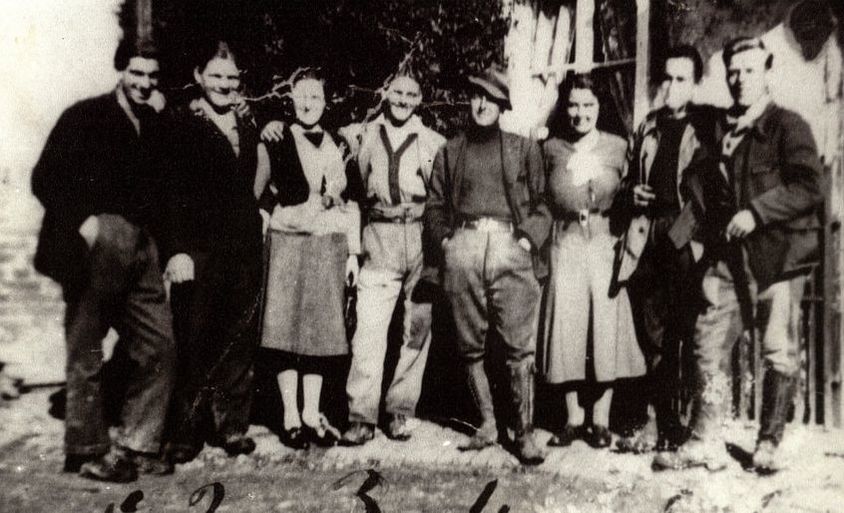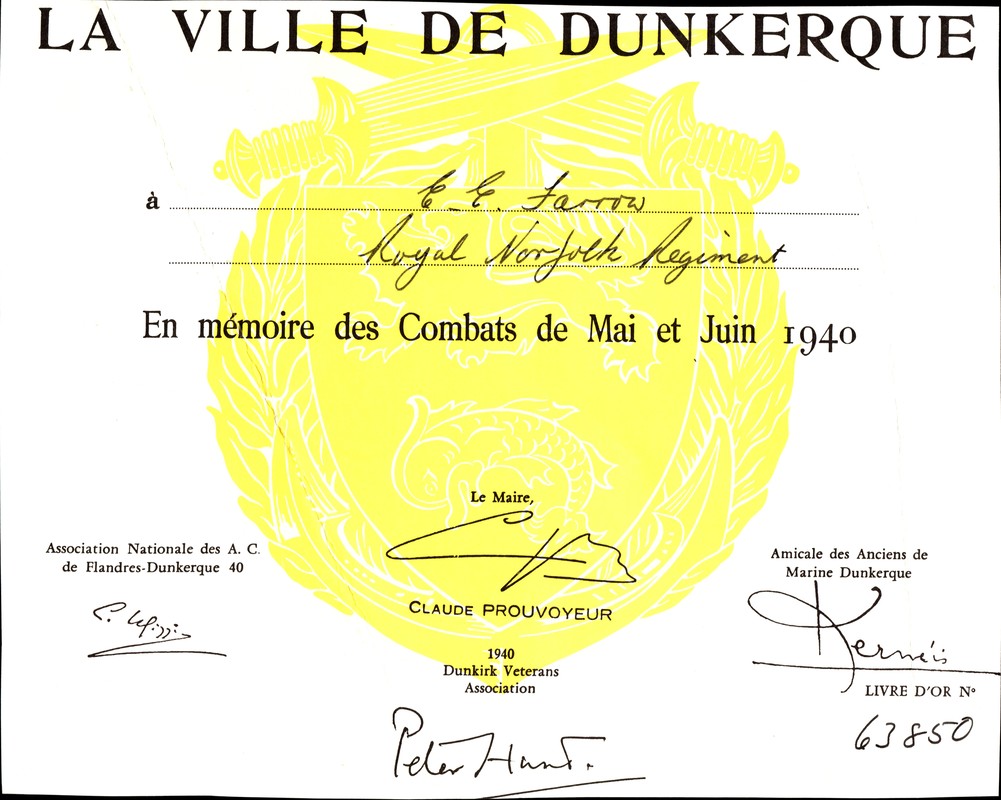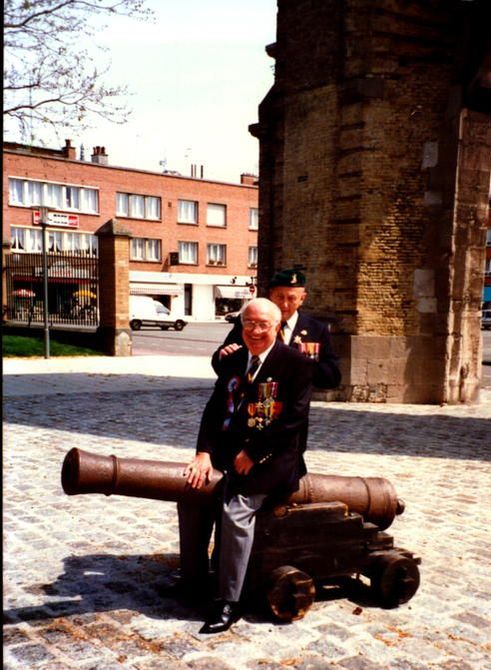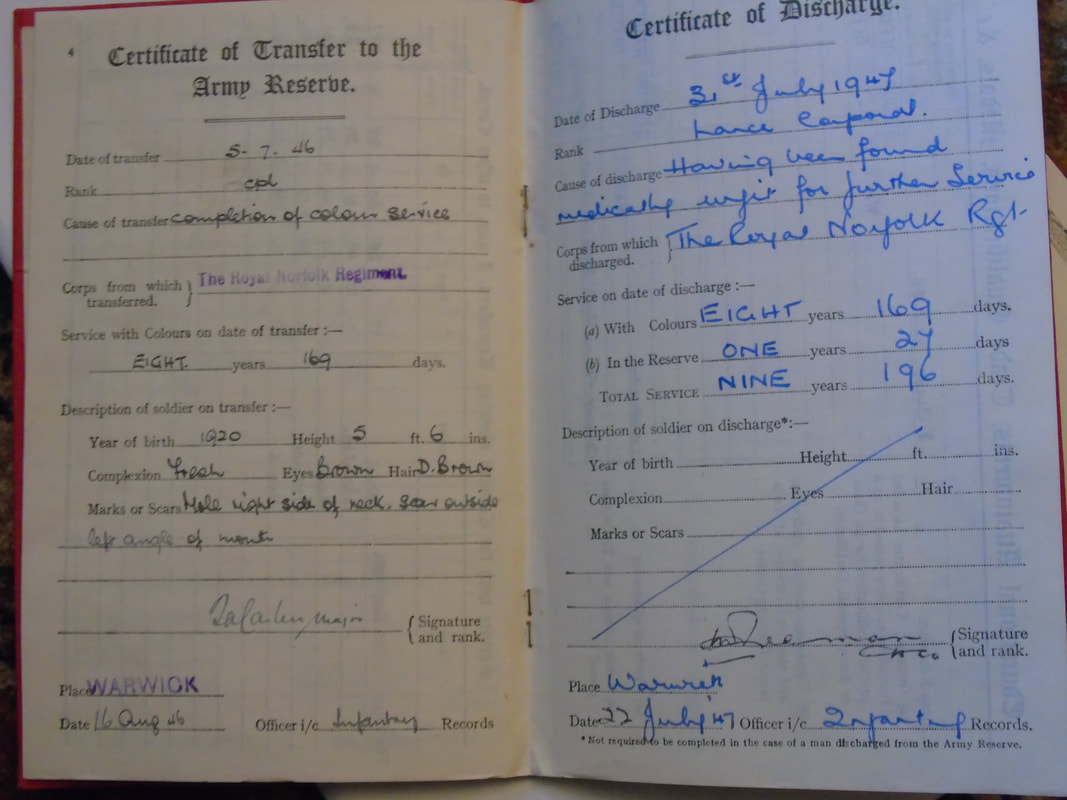Ernest Eric "Strips" Farrow

Ernest Eric Farrow was known to family as Eric, but to everyone by the nickname Strips. Nobody seems to know where this nickname came from but it is how we will refer to him on this special page to his memory.
Strips will always be known as "the man who missed the massacre" thanks to the fact that orders sent him elsewhere as we will explain.
Strips' story is featured in "The Man Who Missed The Massacre" by Cyril Jolly and much of which follows is taken from that book with the permission of the Jolly family and Strips' daughter and son-in-law Emma and Charles Bartram.
Strips was born in White Hart Street, Aylsham, in February, 1920, and attended the village school at Roughton in North Norfolk where his parents had a cottage. Sadly his mother died and Strips went to live with his grandparents in Hungate Street, Aylsham. He left school at the age of 14 to become "a house boy" (servant) at Heath House in Roughton and at the age of 16 started work in a gravel pit at nearby Corpusty. The work was heavy and the hours long and Strips would dig, load and sieve gravel. Strips was a country boy at heart but his family found it difficult to make ends meet and the young Strips often found himself going hungry.
He became desperate to "improve his lot" in life and decided to walk over 20 miles into Norwich to join the army at Britannia Barracks. Never the biggest of men, the young Strips was under age for signing up but, in the words of Cyril Jolly, aged a year going up Mousehold Hill in Norwich. Alongside Strips was a friend from Aylsham - Leslie Chamberlain
So Strips became a soldier in the Royal Norfolk Regiment and also took up the trade of carpentry. He also learnt about the use of explosives and weapons, something that would ultimately save his life.
In September, 1938, be saw service in Gibralter before being stationed prior to the Second World War in Hampshire where he underwent further training. Strips' battalion were still in Hampshire when war on Germany was declared. Strips' Royal Norfolks joined up with the Royal Scots and other brigades and became involved in digging trenches and anti-tank pits during what was known as "The Phoney War."
Much of what Strips subsequently experienced was part of the desperate attempt to halt the German advance as described in our run up to the massacre section. So where exactly was Strips' Farrow on the day of the massacre - 27th May, 1940?
Cyril Jolly explains the situation brilliantly: "The reason Ernest Farrow's name was not among those of the 166 dead in the British cemetery at Le Paradis, which included the 97 bodies of the murdered men, was a fact of duty. On that fateful day when the 2nd battalion of the Norfolk Regiment was practically wiped out he was given an order which saved his life."
Strips had been involved in heavy fighting with the Germans before dropping back to battalion headquarters at Duriez Farm. Volunteers were sought to blow up a bridge across a nearby river to hamper the German advance. Strips volunteered along with three others. As they approached the bridge in a Humber car, they came under fire. They managed to get out of the car before some of the enemy bullets hit the explosives on board and blew it up. The four survivors headed for a river which they swam across. Strips was physically attacked by a German soldier who hit him with a rifle butt.
Strips believed the end had come, but he was taken prisoner. For Strips that was only the start of an adventure that wouldn't be out of place in the pages of the famous "Boys' Own" paper.
To cut a long story short, Strips escaped from a party of prisoners-of-war and went on the run in France with two colleagues - one of whom was later killed by the Germans. The remainder of Strips' war story is one of bravery, determination in the face of adversity, the heroism of French Resistance fighters to support him and the treachery of others.
Strips' escape included long marches through France before crossing the border into Spain where he was a prisoner once again. Eventually Strips found his way to Gibralter before being repatriated to the United Kingdom and back to Norwich where he spent some time in a military hospital. His knowledge of explosives was later put to good effect for training purposes on Norfolk beaches. He was discharged from the army in June, 1946, on medical grounds and went on to work for the railways in the signal and telecommunications field in Norwich before retiring in 1985.
Strips will always be known as "the man who missed the massacre" thanks to the fact that orders sent him elsewhere as we will explain.
Strips' story is featured in "The Man Who Missed The Massacre" by Cyril Jolly and much of which follows is taken from that book with the permission of the Jolly family and Strips' daughter and son-in-law Emma and Charles Bartram.
Strips was born in White Hart Street, Aylsham, in February, 1920, and attended the village school at Roughton in North Norfolk where his parents had a cottage. Sadly his mother died and Strips went to live with his grandparents in Hungate Street, Aylsham. He left school at the age of 14 to become "a house boy" (servant) at Heath House in Roughton and at the age of 16 started work in a gravel pit at nearby Corpusty. The work was heavy and the hours long and Strips would dig, load and sieve gravel. Strips was a country boy at heart but his family found it difficult to make ends meet and the young Strips often found himself going hungry.
He became desperate to "improve his lot" in life and decided to walk over 20 miles into Norwich to join the army at Britannia Barracks. Never the biggest of men, the young Strips was under age for signing up but, in the words of Cyril Jolly, aged a year going up Mousehold Hill in Norwich. Alongside Strips was a friend from Aylsham - Leslie Chamberlain
So Strips became a soldier in the Royal Norfolk Regiment and also took up the trade of carpentry. He also learnt about the use of explosives and weapons, something that would ultimately save his life.
In September, 1938, be saw service in Gibralter before being stationed prior to the Second World War in Hampshire where he underwent further training. Strips' battalion were still in Hampshire when war on Germany was declared. Strips' Royal Norfolks joined up with the Royal Scots and other brigades and became involved in digging trenches and anti-tank pits during what was known as "The Phoney War."
Much of what Strips subsequently experienced was part of the desperate attempt to halt the German advance as described in our run up to the massacre section. So where exactly was Strips' Farrow on the day of the massacre - 27th May, 1940?
Cyril Jolly explains the situation brilliantly: "The reason Ernest Farrow's name was not among those of the 166 dead in the British cemetery at Le Paradis, which included the 97 bodies of the murdered men, was a fact of duty. On that fateful day when the 2nd battalion of the Norfolk Regiment was practically wiped out he was given an order which saved his life."
Strips had been involved in heavy fighting with the Germans before dropping back to battalion headquarters at Duriez Farm. Volunteers were sought to blow up a bridge across a nearby river to hamper the German advance. Strips volunteered along with three others. As they approached the bridge in a Humber car, they came under fire. They managed to get out of the car before some of the enemy bullets hit the explosives on board and blew it up. The four survivors headed for a river which they swam across. Strips was physically attacked by a German soldier who hit him with a rifle butt.
Strips believed the end had come, but he was taken prisoner. For Strips that was only the start of an adventure that wouldn't be out of place in the pages of the famous "Boys' Own" paper.
To cut a long story short, Strips escaped from a party of prisoners-of-war and went on the run in France with two colleagues - one of whom was later killed by the Germans. The remainder of Strips' war story is one of bravery, determination in the face of adversity, the heroism of French Resistance fighters to support him and the treachery of others.
Strips' escape included long marches through France before crossing the border into Spain where he was a prisoner once again. Eventually Strips found his way to Gibralter before being repatriated to the United Kingdom and back to Norwich where he spent some time in a military hospital. His knowledge of explosives was later put to good effect for training purposes on Norfolk beaches. He was discharged from the army in June, 1946, on medical grounds and went on to work for the railways in the signal and telecommunications field in Norwich before retiring in 1985.
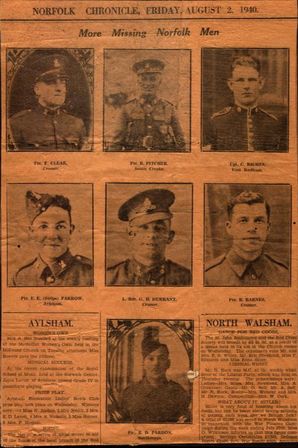
During the war, Strips' relatives were notified by the War Office shortly after the Dunkirk evacuation that he was missing. After several months of no news, they assumed he had been killed. So they were overjoyed and not a little surprised when he turned up.
It is rather ironic that it wasn't until 1960 that Strips' found out about Cyril Jolly's major work on the Le Paradis Massacre "The Vengeance of Private Pooley". It was the first Strips new about the murders of his former comrades. We end with Cyril Jolly's final words in "The Man Who Missed the Massacre."
"The Platoon Sgt Major who had ordered him to go with four others to destroy a bridge, had saved his life, although it led to his capture and countless hardships in a twelve-month escape through enemy-held countryside."
In the Norfolk Chronicle feature on missing men (reproduced opposite), Strips is featured on the left of the second row.
Strips died on 23rd January, 1998, at the age of 77.
All photographs and documents used on this page are from the private collection of Charles and Emma Bartram and reproduced with their kind permission.
It is rather ironic that it wasn't until 1960 that Strips' found out about Cyril Jolly's major work on the Le Paradis Massacre "The Vengeance of Private Pooley". It was the first Strips new about the murders of his former comrades. We end with Cyril Jolly's final words in "The Man Who Missed the Massacre."
"The Platoon Sgt Major who had ordered him to go with four others to destroy a bridge, had saved his life, although it led to his capture and countless hardships in a twelve-month escape through enemy-held countryside."
In the Norfolk Chronicle feature on missing men (reproduced opposite), Strips is featured on the left of the second row.
Strips died on 23rd January, 1998, at the age of 77.
All photographs and documents used on this page are from the private collection of Charles and Emma Bartram and reproduced with their kind permission.
John Head writes - "Strips" was in the Battalion’s Pioneer Platoon which was crucial in filling the gap between A and C companies. They were involved in fierce fighting before 10 pioneers , including Strips , returned to Duriez Farm where he volunteered to destroy the Pont d’Avelette (Bridge).
The following extract is taken from Richard Lane's book "Last Stand at Le Paradis" and used with permission.
"On Saturday 25th, Norfolks moved into position by Canal d’Aire (La Bassee). A and C were in position but contact lost with B and D ....there was a gap between A and C which had to be filled until B and D were in correct position but this could not be done until after dark. So Battalion’s Pioneer Platoon ( inclusive of Strips) were ordered to fill the gap. Only 20 Pioneers including Strips remained, 8 having already been lost."
Strips gave this personal account of the situation -
"What they told us to do was go up on the top of this canal bank and make sure that every round that we fired got a German. We were getting short of ammunition and we must try and make every round count . I was using my .303 rifle. Occasionally we took turns firing the Bren gun but there again we had to be careful. We found that by using the rifles we could save quite a lot of ammunition. We could pick a German off with our rifle just as well as we could do with the Bren gun, where you’d fire probably twenty rounds to hit the same German. After we’d fired a certain amount of rounds, we’d scramble back down the bank of the canal, run along a bit, then go to the top again, just to try and bluff the Germans that there was a great company of us there. We were hard pressed. We were being machine gunned , shelled."
Later the pioneers were supported by a unit of machine gunners from the Manchester Regiment.until B and D moved into its correct position.
The following extract is taken from Richard Lane's book "Last Stand at Le Paradis" and used with permission.
"On Saturday 25th, Norfolks moved into position by Canal d’Aire (La Bassee). A and C were in position but contact lost with B and D ....there was a gap between A and C which had to be filled until B and D were in correct position but this could not be done until after dark. So Battalion’s Pioneer Platoon ( inclusive of Strips) were ordered to fill the gap. Only 20 Pioneers including Strips remained, 8 having already been lost."
Strips gave this personal account of the situation -
"What they told us to do was go up on the top of this canal bank and make sure that every round that we fired got a German. We were getting short of ammunition and we must try and make every round count . I was using my .303 rifle. Occasionally we took turns firing the Bren gun but there again we had to be careful. We found that by using the rifles we could save quite a lot of ammunition. We could pick a German off with our rifle just as well as we could do with the Bren gun, where you’d fire probably twenty rounds to hit the same German. After we’d fired a certain amount of rounds, we’d scramble back down the bank of the canal, run along a bit, then go to the top again, just to try and bluff the Germans that there was a great company of us there. We were hard pressed. We were being machine gunned , shelled."
Later the pioneers were supported by a unit of machine gunners from the Manchester Regiment.until B and D moved into its correct position.
Strips' Scrapbook
Below are photographs of Strips' including a number taken from his time on the run in France where he passed himself off as a Frenchman on a number of occasions. Click on the images to enlarge them.
Below are photographs of Strips' including a number taken from his time on the run in France where he passed himself off as a Frenchman on a number of occasions. Click on the images to enlarge them.
|
|
|
|
